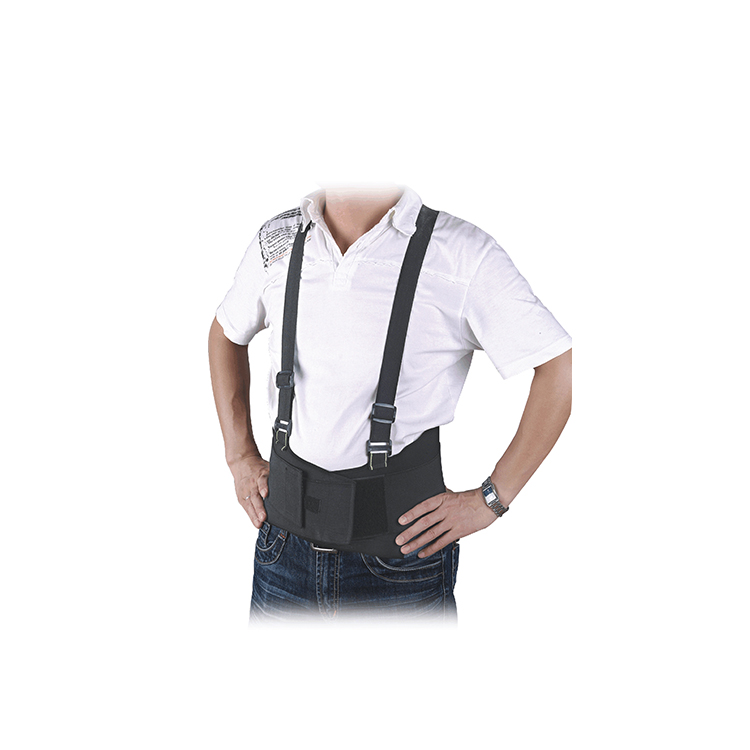As one of the China’s leading work safety belts factory since 2009, we would like to share What a safety support belt is for. A work safety support belt, also known as a back support belt or lifting belt, is intended to give support to the waist and back while reducing the risk of damage in heavy lifting, repetitive bending or twisting. It’s suitable for a variety of tasks, including lifting, prolonged standing, and even during exercise.


Key Features on Safety Back Support Belt
The adjustable straps allows for a snug fit that provides optimal support without being too restrictive; the elastic material is often made from a combination of neoprene, spandex, or elastic for flexibility and comfort; the reinforced lumbar pads can provide extra support to the lumbar spine, helping to alleviate discomfort or prevent injuries; the breathable design can keep the back cool, even during intense physical activity, preventing excessive sweating; and the Velcro or Hook-and-Loop fasteners can help ensure the belt stays securely in place during use.
Who Need the Back Support Safety Belts
Construction workers, who are involved in heavy lifting, bending, and other physically intensive tasks are more often at a higher risk of back injuries.
Warehouse and factory worker whose jobs are related to constant lifting, moving, and stacking of materials or products are risking repetitive stress injuries, especially in the lower back.
Farm workers, who are engaging in tasks such as lifting, shoveling, or loading equipment could suffer from pains from the lumbar region.
Nurses and caregivers, who frequently help with lifting or transferring patients, may have to do with awkward positions that can strain the lower back.
Physical therapists and chiropractors, who assist others in avoiding injuries can be exposed to injury risks.
Delivery drivers, who have to lift packages and transport heavy goods between vehicles and customer locations are often upset about back injuries.
Logistics and shipping workers, who frequently and repetitively handle packages and materials in warehouses in awkward postures can have back pains.
Stock clerks, who need constant bending, lifting, and carrying of goods to stock shelves can go through severe back injuries.
Weightlifters and bodybuilders, who lift heavy loads during weight training can be affected by the lower back. A safety back belt can help stabilize the core and reduce the risk of injury.
Sports participants, suffering from repetitive back movements or impact (such as rowing, gymnastics, or football) may need extra lumbar support.
Truck drivers and long-distance drivers, who often sit for prolonged periods can feel wretched about lower back problems. A back support belt can offer support and help maintain proper posture during extended periods of driving.
People who sit for long hours with poor posture or without proper lumbar support can benefit from wearing a back support belt.
Those recovering from a back injury (such as muscle strain or herniated disc) might wear a back support belt as part of their recovery process to provide extra stability and support during movement.
Older adults, particularly those with osteoporosis or degenerative spine conditions, may benefit from extra lumbar support when performing daily activities to avoid injury.
Home caregivers often have to lift, carry, or reposition people with limited mobility, which increases their risk of back injuries.
What It’s Used for & Why It Matters?
1. Back and Lumbar Support
A work safety support belt primarily supports the lower back and abdominal muscles. That could successfully reduce tension on the spine, especially in heavy lifting, bending, or physically demanding jobs; besides, the safety support belt can help alleviate existing mild lower back pains.
- Injury Prevention
Improper lifting of heavy objects can cause serious injuries like muscle strains, sprains, and long-term spine injury. The support belt helps employees maintain right posture and avoid improper lifting practices. The restricted lower back motion can reduce the risk of injury from over-extension or twisting. - Encouraging Proper Lifting Techniques
Wearing the back support belt reminds you to lift by using your legs and knees instead of your back. Workers are advised to life by bending at the knees rather than the waist in case of back strain. It can also not only reduce the risk of injuries including herniated discs and muscle tears, but also serve as a training tool for new employees to get the right lifting skills.
- Fatigue Reduction
Wearing a safety belt helps prevent muscular tiredness after long time of strenuous exertion. By supporting the core muscles, the belt relieves some of the tension on the back. Only in this way, can workers operate for extended periods of time without being fatigued or uncomfortable.
- Rehabilitation and Recovery ·
Back injury workers can use a safety support belt to brace their lower back to get back the strength and mobility. This adds extra support and helps to prevent re-injury during the healing process.
- Reducing Absence Rate and Workplace Injuries
Back injuries are one of the main reasons for absence rate in construction, warehousing, manufacturing, and logistics. A lift belt reduces the likelihood of the injuries. As a result, fewer people would ask for leaves due to injury, which could increase the overall workplace productivity.
Limitations
Support belts is helpful for back and waist safety, but can not replace good training and ergonomic lifting skill practicing. Over-reliance on support belts without adequate technique might still cause damage to spine or muscle hurts. Back support belts should be used together with good lifting techniques and back-strengthening exercises to prevent muscular weakening from working long.
Conclusion
A work safety support belt is an effective tool for decreasing back strain, preventing injuries, and promoting appropriate posture during physically demanding tasks. It protects workers’ health, particularly in industries that involve regular heavy lifting, but it must always be used under the guidance of safe working procedures and and with suitable lifting skills.
If you have any interesting of back support belt, contact us to learn more https://toprisesafety.com/contact-us/
More information about back support belt https://en.wikipedia.org/wiki/Back_belt


